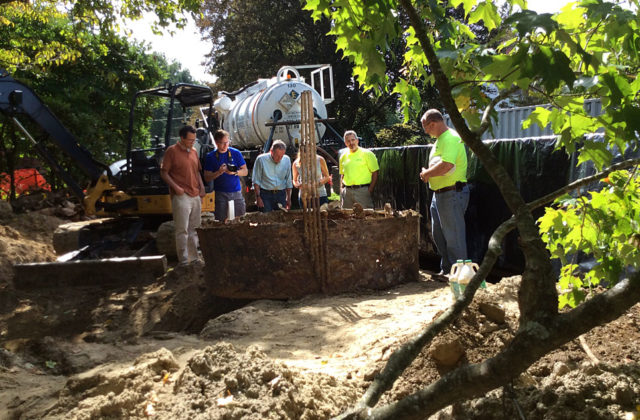Coal Oil Tank Behind Library Safely Unearthed
Environmental effects are being monitored
By Michael Kelly
During excavation for the Norfolk Library’s new handicapped access ramp, pipes were unearthed that led to a mysterious gas tank buried behind the library’s great room. After much head-scratching and research, it was determined that the tank was part of a then-sophisticated 19th-century technology that, before electricity came to town, was used to provide lighting for homes and public buildings.
In our environmentally enlightened age, covering up the tank and forgetting about it was not an option. Government agencies were alerted and came quickly on the scene to assess and monitor the intriguing situation. Berkshire Environmental Services, an environmental consulting and remediation company from Torrington, Conn. took soil samples and methodically set about digging the possibly contaminated tank out from of its century-long hibernation. Norfolk’s volunteer firefighters set up a safety perimeter and stood by vigilantly during the entire proceedings.
Radar testing had indicated that there were two underground tanks but as the backhoe dug deeper, it was discovered that one of the shadowy figures was nothing but a big boulder. Contaminated soil was deposited into metal drums and transported to protected sites where it could be examined and disposed of. Sludge in the bottom of the tank, the residue of coal oil, emitted a strong odor. A specialized firm from Albany, NY was called in to dispose of the sludge and the smell of gas soon dissipated harmlessly into the air.
Six weeks after the existence of the gas tank had become known, there it was above ground, having been successfully extricated from its covert bunker, a rusty 1880’s reminder of the Victorian era. It turned out to be a corroding circular metal tank, 7 feet wide and 5 feet tall, with a wood floor and layers of burlap and wooden planking which were probably meant to absorb and contain leakage. For safety reasons the tank was quickly dismantled and taken in metal drums to a hazardous waste dump for inspection and disposal. A boring machine is continuing to test the soil behind the library to determine whether there is any further contamination. With the tank now gone, installation of the handicapped access ramp is back on track for completion this fall.
After all the time and expense put into extracting the tank from its hiding place behind the library, the aftereffects seem, mostly, to be benign. Which begs the question: would it have been better, as several Norfolk old timers knowingly suggested, to just let the sleeping tank lie, and forget about it for another 100 years, as did our wise Norfolk antecedents?
Photograph by Michael Kelly.

